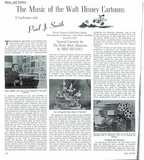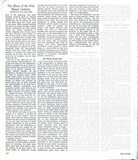

Musical Director of Walt Disney Studios
Joint Composer of "Pinocchio", "Snow While" and Other Successful Films
The musical settings of the Disney cartoons fills a niche all its own. Our music is "motion picture" music, true enough; but its purpose is quite different from that of the background music of life-action films, where the dramatic play is calculated according to ordinary human psychology. It must be comprehensible to children, without in any way ranking as juvenile. It must complement the action and at the same time remain subordinate to it. At no time may dialogue be disturbed, yet the score must be considerably more complete than that of the life-action picture. An animated cartoon is an unusually closeknit unit. Music, dialogue, and visual effects must accomplish their goal in a comparatively short time, because the specific demands of cartoon psychology call for a great deal of diversified action. Thus, while it ranks as lighter entertainment, it must be all concentrated red meat, without leisurely saunterings down by-paths of interest. And, of great importance, interest must be held without too much insistence on love ("Pinocchio" has no love interest at all). These are some of the considerations that govern the preparation of our scores.
We begin musical work with the song material, leaving the full orchestral score for much later. When the story and characters have been established, the general style of the desired songs is outlined to our staff. In preparing "Snow-White", for instance, our composers were trying out effects to express Snow-White‘s romantic interest, and the antics of the dwarfs, long before the actual drawings were completed. In "Pinocchio" the affection between father and child, and the conscience symbolism of Jiminy Cricket, were dealt out as theme provokers during the earliest stages of production. The number and type of matured songs are also decided in advance. Always, there must be one to symbolize affection, and one to sound the adventure note in a march rhythm (Heigh Ho! from "Snow-White", and Hi! Diddle Dee Dee! from "Pinocchlo"); the three or four other musical expressions of emotion depend on the story material. It is impossible to say how long it takes to complete a song. A "natural" may appear after only a week; it may take months to work out a single phrase.
[…]
| Id | 1934 |
|---|---|
| Availability | Free |
| Inserted | 2015-11-30 |